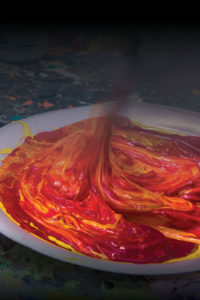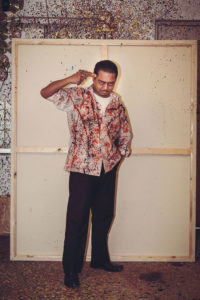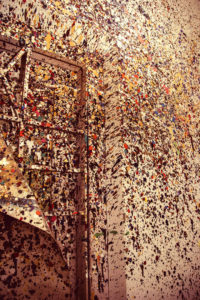What can I say ?
Looking around, inspiration is there for the taking.
 Artists are akin to thieves, cannibals and vampires. Art begins with the things that set it off. One takes whatever one is drawn to, whatever is necessary. And then rolls the dice.
Artists are akin to thieves, cannibals and vampires. Art begins with the things that set it off. One takes whatever one is drawn to, whatever is necessary. And then rolls the dice.
I found things. They also find me. You know you're in too deep when you can't get away.
Where do I begin? What made me cross a line? It's not easy to put it down to one point. But there are things that stop you in your tracks.
There is the sensual charge of colour. The abandon of improvisation in music. The compelling presence of tribal art. The instant action of zen. The pleasure of mark-making. The reality of non-illustrational representation. The autonomy of the calligraphic gesture.
 But if you look, you may not leap.
But if you look, you may not leap.
That seems to be the implicit demand of improvisation. There's a contradiction here- you can't cook if you don't know the ingredients, know how they behave. So investigation is required. But after all that, you do need to jump.
It is the actual process that allows elements to be used and abused (as required). There are variables and variations that can intersect, overlap, combine and enhance each other. Or they can contradict and collide. Things can be torn apart. One pushes for the possibility of transformation, and courts unpredictability while creating an image. Who knows what lurks around the corner? All the more reason to keep looking.
One's environment always somehow seeps in. Being in Kolkata is a visceral experience. It is a place where walking down the street can be a strange feast of the bizarre, banal, filthy, primal and sublime all at once. It is a unique assault on perception. Soaking in this level of sensory saturation translates easily into the physicality of painting.
Colour can function as a pure energetic value Used like that, it can have an immediate impact, without having to describe the world in conventional terms. What you see is what you get.
Used like that, it can have an immediate impact, without having to describe the world in conventional terms. What you see is what you get.
The excellent intoxication of tribal art has nothing to do with imitating traditional forms. It is about responding, picking up on a driving force. That simplicity is seductive but it does not function like a formula. And it does not come from a process of breaking down studies and sketches. The implication is another process altogether. The guiding logic has to come from a way of seeing things, a way of feeling things.
This comes from a tradition dealing with archetypes. They are relevant before and beyond a contemporary time frame. It is about re-creating reality as opposed to simply representing it. But it is no make-believe world either. Looking hard, one sees what focuses that kind of work is a commitment to tapping into the essence of things. Discipline and insight are inextricable.
Zen emphasizes non-intellectual insights. It demands action. The right move at the right moment. How does one do this? Where does it come from? No one really knows. Unpremeditated intervention is encouraged. So is minimum interference. One is reminded of Miles Davis' seminal album, 'A Kind of Blue'. It is no accident that the pianist, Bill Evans, uses a comparison to zen painting in the liner notes to describe the musical processes at work. Letting go means allowing something else to take over.
The procedure relies heavily on intuition. That is the resource one is compelled to develop. Which implies that what goes on can never really be articulated- at best it can only be intelligently alluded to. Perhaps that is why Francis Bacon always insisted it was impossible to talk about painting.

